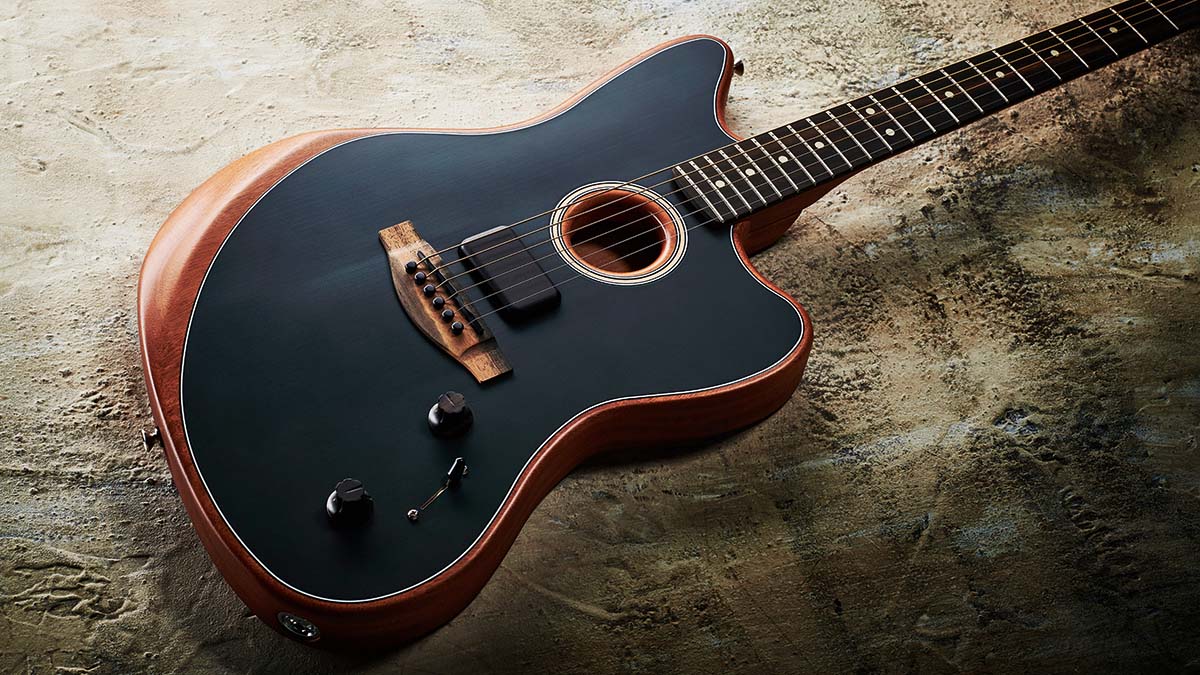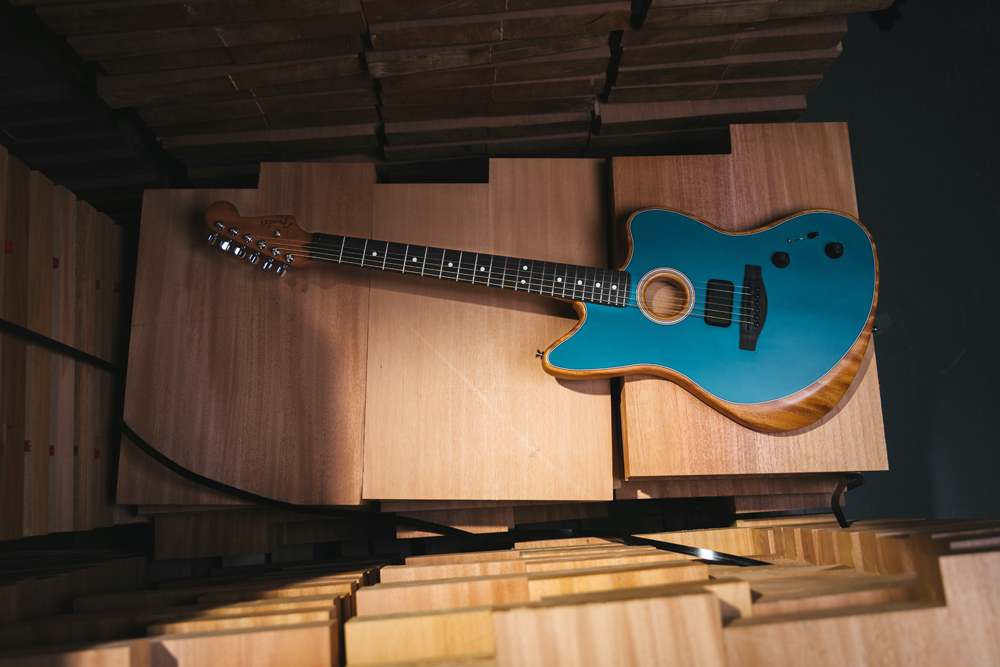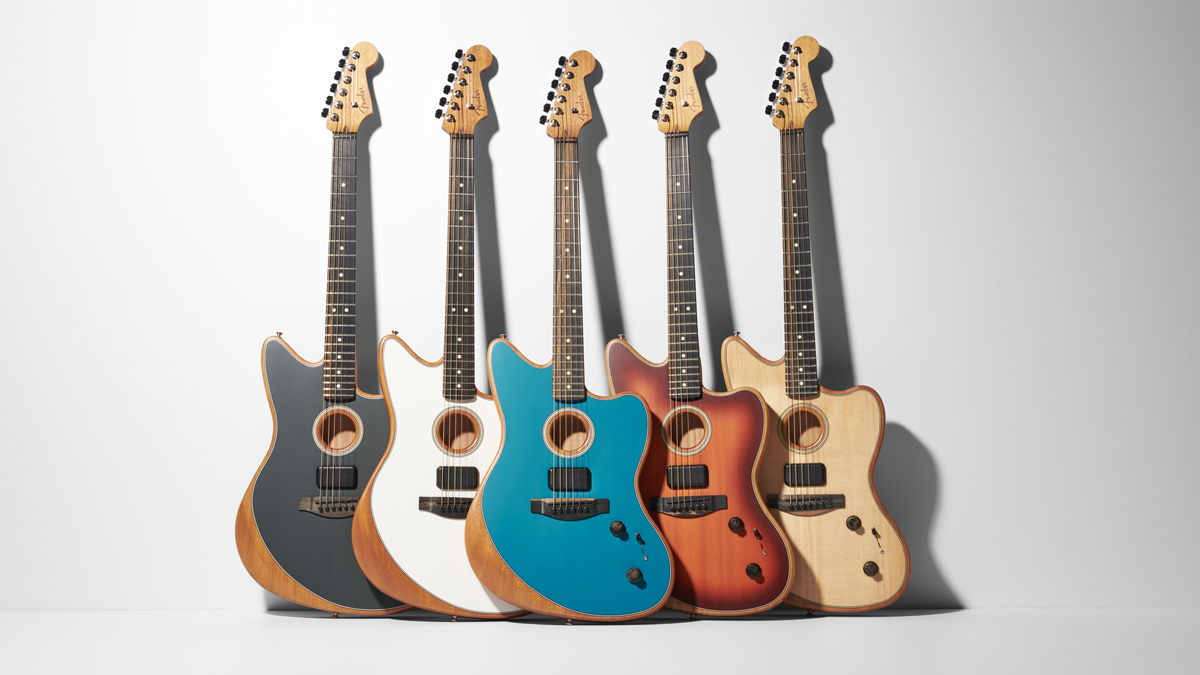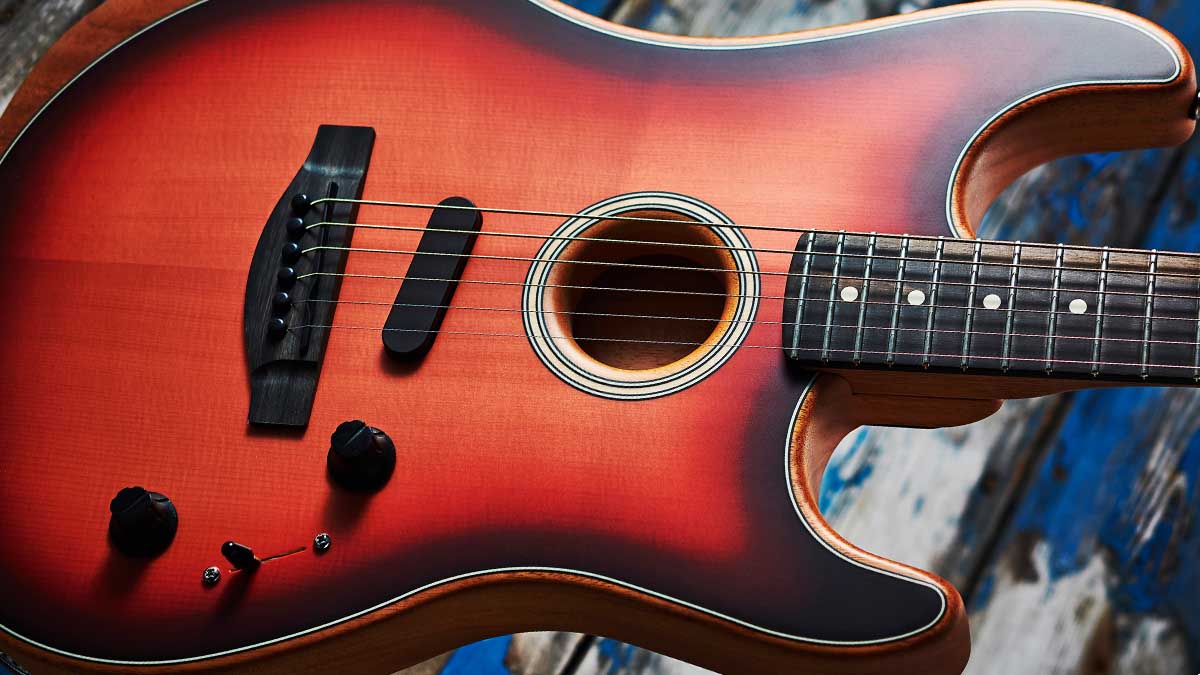Fender's Tim Shaw on the making of the American Acoustasonic Jazzmaster
How the latest addition to the Acoustasonic family pushed the design team in “different and interesting directions”

Breaking the rules is a key part of the design of the American Acoustasonic platform. It’s a concept that really shouldn’t work, but with the release of this Jazzmaster, the third version, it clearly does. It was just as much a surprise as the original Telecaster model when it was unveiled at the NAMM Show back in January 2019.
“You kept pretty quiet about this one,” we say as we settle into our chat with Tim Shaw, although we’re surprised by his response: “Originally, we thought the Jazzmaster would come before the Strat. I forget what the reasoning was, but, obviously, we did the Strat first.”
One reason for that potential switch could well have been the larger body size of the Jazzmaster. Despite the solidbody shape, these Acoustasonics are acoustic guitars first and proving that could work was fundamental to the concept originally imagined by Brian Swerdfeger, Fender’s VP of research and design.
“I had the idea three years ago and enlisted Tim Shaw and Larry Fishman to help bring it to life,” Brian told us in 2019. The key lay in the sound port – originally referred to as the ‘Stringed Instrument Resonance System’ (SIRS) – the lightly braced top and, of course, the mainly hollow body.
“The design, size, location and depth [of the port] all contribute to the voicing of the instrument,” said Brian, “and give it a fuller voice on your lap. This voicing, in concert with the movement of the top, are major components of what you hear when the guitar is plugged in. What you hear from the output jack is 55 percent from the guitar and analogue circuit, and 45 percent shaped by the electronics.”

Back to today and Tim Shaw joins us from his Nashville base to go deeper into the new Jazzmaster concept.
Did you find that the Jazzmaster was tricky to voice in regard to its body size and resonance?
Get The Pick Newsletter
All the latest guitar news, interviews, lessons, reviews, deals and more, direct to your inbox!
“Actually, it wasn’t all that hard. The trick is that there is a whole lot more real estate on the top because it’s larger and the Helmholtz resonance was lowered – because of the cavity size – from the start. We built up the first prototype and immediately realised it was going to have more [acoustic] volume.
“Initially, we figured out what the cavity might look like because there’s a whole lot more to route in there. If you remember, although the Strat looks bigger than a Tele it actually has less room inside it. This one was not acreage… but there’s certainly an allotment or two in there [laughs]. So, after we listened to the first one we modified the cavity a little bit – because there was one resonance I wanted to get rid of – and extended the bracing on the treble side a little bit further down. But we did very little to the sound port in terms of tuning it at all. So this one was more cavity, less port!
It’s more responsive against your body, and the extra information from the top is giving us more acoustic subtlety that we didn’t get with the Strat – the smallest of the three in the way in which the top works
“It ended up pushing us in different and interesting directions. I mean, I think the whole family of sounds here are more high-definition, if you want to call it that, than on the other guitars. It’s more responsive against your body, and the extra information from the top is giving us more acoustic subtlety that we didn’t get with the Strat – the smallest of the three in the way in which the top works. It was a lot of fun because it just gave us more to work with. It’s like, err, a painter having five extra colours, or having a horn section you can write for!”

Speaking of extra colours, the Lo-Fi Piezo voice (2A) is just the under-saddle pickup, correct?
“I don’t know if the final mix ended up with a little bit of the guitar in there, but, basically, yes: it’s the under-saddle pickup, buffered, but otherwise pretty much straight out, so a lot of the snazzy stuff is gone. When we first heard that sound at Fishman, it was kind of a happy accident.”
It’s the sound of amplified acoustics we’ve grown up with on live recordings or performances, anyone from The Rolling Stones in concert to Oasis.
“Absolutely! It’s like the P-Bass started being used for recording because it sounded good through a five-inch car speaker, so we all grew up knowing that a P-Bass with flat-wounds was ‘how an electric bass guitar is supposed to sound’. It kind of became embedded in our sonic DNA, if you like. When you hear that Lo-Fi piezo, and I think we’re using it in a playful context, it’s exactly what you’ve just pointed out: it’s all this stuff we’ve heard for years. And now we can kinda tip our hats and say, ‘We think this sounded cool. Check it out.’”
Because the Jazzmaster has such a reputation as an alt instrument, kind of a grunge thing, we felt we had the liberty to mess with that sound
Is the Lo-Fi Crunch voicing (2B) using the same tone stack as the clean electric (1A and B)?
“No. I want to say it’s more… for lack of a better term… AC30-ish. It’s a completely different tone stack to the one we use on voice 1. It’s a small valve amp, basically. I think we were sort of on a route to somewhere else when we heard that and said, ‘Wait a minute, what’s that?’”
It makes the Jazzmaster seem more ‘electric’ than the previous two Acoustasonic models…
“I think the acoustic sound-pairs sound really, really good: voices 3 to 5. You’ve got a ton of useful stuff, seriously musical, I believe. I think on voice 2 – this Lo-Fi piezo sound – because the Jazzmaster has such a reputation as an alt instrument, kind of a grunge thing, we felt we had the liberty to mess with that sound instead of going, ‘Yes, we need one more acoustic then a final clean electric sound.’ So we thought, ‘What the hell? It’s a Jazzmaster!’”

We talked about how people are playing their electric guitars in a different way today. The pandemic has amplified that.
“Yes, absolutely. That was a part of the mission statement for the [Acoustasonic] guitar. Brian and I talked a lot about this. People don’t play guitar like they did before. A lot of people are doing exactly what you’re doing: running into a DAW and listening on headphones. This kind of platform suits that well. The sitting playing your acoustic on your lap with a few friends, particularly during the pandemic, went away entirely.
“I was saying in the first promo video for the Jazzmaster that different guitars make us play differently. You play different stuff on a Tele or Strat to the way you do on a Les Paul. I think you did a Longtermers piece on a guitar last year that I wasn’t familiar with [the Nik Huber Piet] and you said something similar: we’re different players on different things.”
If ‘revolution’ is too strong and ‘paradigm shift’ is a little too tech-y, we’re still leaning towards that end of the equation with it
This Jazzmaster especially reminds us of early amp modellers, such as Line 6’s POD, that revolutionised the way we could capture an amp sound. We’re not saying the Acoustasonic is a revolution, but…
“If ‘revolution’ is too strong and ‘paradigm shift’ is a little too tech-y, we’re still leaning towards that end of the equation with it. The platform has been out now for, well, this is the third year. Some of the studio guys initially said, ‘Well, I’m just going to stick with my rack full of Martins and Gibsons and my Neumann mics, thanks very much.’
“But we’ve actually seen increasing adoption at their level: ‘Man, I can just work so fast.’ And in the context of a mix where a lot of the nuance of a beautiful mic’d and recorded acoustic is going to evaporate anyway – all that high-end sweet stuff is going to disappear under the cymbals – this is just a really, really useful tool. And that, too, was part of the original design brief: precisely that.”
Maybe it’s our familiarity, but the Jazzmaster seems less about the accuracy of the acoustic voices – it just travels very intuitively from acoustic to electric as you move through the five-way selector switch.
“It feels more intuitive, I agree. On voice 5A, the rosewood dreadnought where it swoops over to the slope shoulder [5B], you can sort or hear where that style of guitar’s compression comes in before you get to the full sound of the second voice. You really do, sound-wise, feel like you’re moving from a dreadnought to a slope shoulder.”
This morphing of two voices did initially feel a little bit alien…
“Well, that’s because it had never been done before. As I think we discussed, Larry Fishman didn’t even think it could be done when we started. There is so much interesting stuff there in the middle – sounds that could not and did not occur in nature.”
The Jazzmaster, of the three Acoustasonics, is the rowdy cousin: the one who’ll take the fourth shot of tequila!
We have a new-design large humbucker here. What’s under the hood?
“Basically, it’s a medium-high output, Alnico II-driven, side-by-side humbucker. I think I wound six different pickups. Three were for the first sound test and we ended up going for the hottest one in that group. Then, probably in mid-summer of last year, Larry called and said, ‘You know, the more we work with the electric sounds, we’re not quite getting enough here. Can you make something hotter?’ And I went, ‘Really? Okay.’
“We did that and ended up with the highest-output pickup of the whole group. It could be a lot closer to the strings because it’s got steel polepieces not magnets, and it just pushed us into the ‘hot humbucker by the bridge’ modality that the other Acoustasonic guitars simply don’t do.
“Again, this harkens back to the kind of rowdy punk/grunge thing, everyone’s modification of the Jazzmaster: the first thing anyone did was to rip out the original pickups and put humbuckers in. So the Jazzmaster, of the three Acoustasonics, is the rowdy cousin: the one who’ll take the fourth shot of tequila!”

Dave Burrluck is one of the world’s most experienced guitar journalists, who started writing back in the '80s for International Musician and Recording World, co-founded The Guitar Magazine and has been the Gear Reviews Editor of Guitarist magazine for the past two decades. Along the way, Dave has been the sole author of The PRS Guitar Book and The Player's Guide to Guitar Maintenance as well as contributing to numerous other books on the electric guitar. Dave is an active gigging and recording musician and still finds time to make, repair and mod guitars, not least for Guitarist’s The Mod Squad.
“It holds its own purely as a playable guitar. It’s really cool for the traveling musician – you can bring it on a flight and it fits beneath the seat”: Why Steve Stevens put his name to a foldable guitar
“Finely tuned instruments with effortless playability and one of the best vibratos there is”: PRS Standard 24 Satin and S2 Standard 24 Satin review










